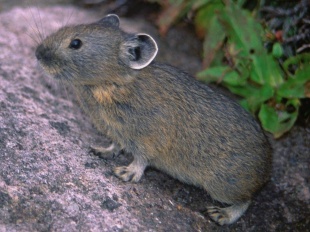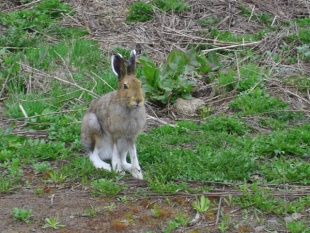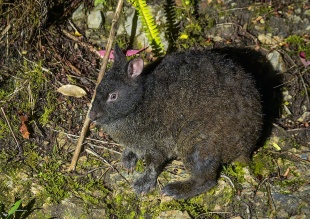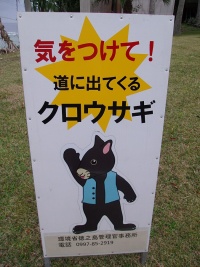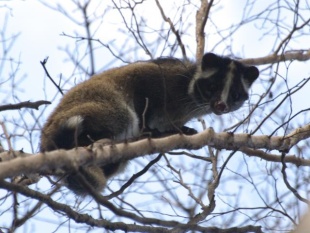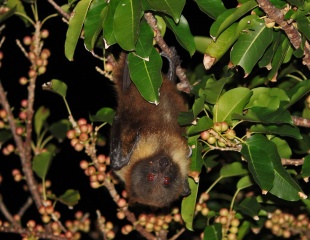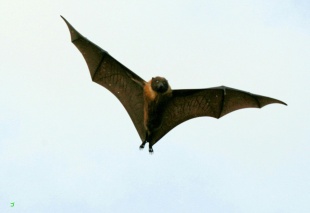HARES AND RABBITS IN JAPAN
The long-eared mammals found in most of Japan are hares not rabbits. The only rabbit is the Amami black rabbit (Amami-no-kurousagi in Japanese, Pentalagus furnessi) found on two islands, Amami Oshima and Tokunishima in northern, Okinawa Prefecture., south of Kyushu The two hare species are the Japanese hare (nihon-nousagi) and the yuki-usagi, or mountain hare (L. timidus).
Kevin Short wrote in the Daily Yomiuri, “Some people think the English words hare and rabbit are synonyms, but these animals are actually quite different. Hares are larger heavier and have longer ears than rabbits. With their longer legs they can out jump rabbits. They tend to live simple shelters known while rabbits usually live in underground warrens. Most species of rabbit give birth in their protected warrens, or burrows, and their kits are born blind and hairless. Hares, in contrast, give birth in a simple ground nest, called a form or scrape, often hidden in a dense thicket. Their young, known as leverets, emerge fully furred and with their eyes open, and in a matter of days are able to fend for themselves.” [Source: Kevin Short, Daily Yomiuri, February 3, 2011]
In Japan there are Shinto shrines dedicated to hares and folk tales and songs written about them. Japanese hares live in Kyushu and Honshu (See Below). A completely different species, the mountain hare, lives in Hokkaido. Japanese hares are related to hares that live in China and Korea. Mountain hares are related to species that live across northern Asia and Europe. The reason for this is that when sea levels dropped during the ice ages animals easily migrated between China, Korea, Kyushu and Honshu and between Russia and Hokkaido but not between Honshu and Hokkaido which are separated by the deep Tsugaru Straits.
“Hares are complete vegetarians, feeding on both soft herbaceous plants and harder grasses and sedges. The Japanese hare was quite at home in the satoyama, or traditional countryside landscape, where woodland undergrowth was typically cut annually, providing an excellent habitat for low-growing herbs and grasses to thrive in.”
More than 100 rabbits killed in the Kanto area around Tokyo during a wave of bunny murders in the summer of 1997.
RELATED ARTICLES:
ANIMALS IN JAPAN: WILDLIFE, BIODIVERSITY, RESEARCH factsanddetails.com
TANUKIS (JAPANESE RACCOON DOGS): CHARACTERISTICS, BEHAVIOR, FOLKLORE factsanddetails.com
BEARS IN JAPAN: CHARACTERISTICS, BEHAVIOR, SPECIES, HUMANS factsanddetails.com
Lagomorphs and Pikas in Japan
Kevin Short wrote in the Daily Yomiuri, “Hares are mammals in the Order Lagomorpha, which also includes rabbits and pikas. Lagomorphs are closely related to rodents, but differ in having two rather than one pair of chisellike incisors in their upper jaw. Like rodents, the lagomorph incisors continue to grow throughout the life of the animal, and are kept honed to a fine edge by constant use. [Source: Kevin Short, Daily Yomiuri, February 3, 2011]
In addition to the two hare species and Amami black rabbit, Japan is home the naki-usagi or northern pika (Ochotona hyperborea), which are found on Hokkaido. Northern pikas are found Russia far west as Ural mountains and in southern Siberia, northern Mongolia, Manchuria, North Korea and Sakhalin Island. Cute and small and resembling a cross between a mouse and a rabbit, they reach lengths of between 12.5 and 18.5 centimeters (4.9 and 7.3 inches), excluding their 0.5-to-1.2 centimeter (0.20-to-0.47 inch) tail. Northern pikas have small rounded ears and short legs and furry soles on their feet. Their fine long hair is reddish-brown in summer but much greyer in winter. The underparts are white tinged with reddish-brown, Sexes look alike. [Source: Wikipedia]
“Lagomorphs neatly illustrate the origin of Japanese mammals. The mountain hare and northern pika are subspecies of common forms that are distributed clear across the Eurasian continent. They most likely entered Hokkaido from the north during a glacial epoch, when that island was connected to Siberia. The Japanese hare, in contrast, is closely related to species in China and Korea, and arrived here from the west; while the black rabbit is a primitive relict species, that originally came from the south when the Ryukyu Islands were connected to Taiwan and the mainland.”
“Lagomorphs utilize a unique digestive system to get the maximum nutrition from course food. Rough fibers are first separated out and excreted. These are the scats we find lying in the fields. The rest of the partially digested food is then wrapped in a thin mucous lining and excreted separately. These special feces, called cecotropes, are immediately reingested and passed through the digestive system a second time.”
Japanese Hares
Kevin Short wrote in the Daily Yomiuri that the “ nihon-nousagi “ or Japanese hare (Lepus brachyurus) is found on the islands of Honshu, Shikoku and Kyushu and is an endemic species, which means it is not native anywhere outside the country. Although quite common in most areas, the hare is highly nocturnal and thus rarely seen. Only tracks in the fields and clusters of round scats reveal its nightly feeding forays.” [Source: Kevin Short, Daily Yomiuri, February 3, 2011]
“Japanese hares mate and give birth several times from early spring through late summer. Hares usually give birth two or three litters a year. Young hares are born fully furred with their eyes open and ready to take car of themselves. Rabbits have many litters. They go through much more trouble to take care of their young. Young rabbits are born naked with their eyes closed.
Like most lagomorphs, their basic strategy is to offset low survival with high reproductive rates. During the breeding seasons males fight one another and females who are not ready to mate kick away ardent males. This wild behavior in an otherwise timid animal is at the base of the old European saying "mad as a March hare." Hares usually stay hidden throughout the daylight hours, an adaptation designed to protect them from hawks and eagles. When flushed by dogs or foxes, they rely on blazing speed to escape. European hares have been clocked at 70 kph.”
Japanese hares that live in northern Honshu are mottled brown in color most of the year. When they days become shorter in late autumn they begin molting and turn white by the time winter arrives. Japanese hares than live in southern Honshu where there isn’t much snow retain their mottled brown color in the winter. The mountain hare of Hokkaido and Japanese least weasel (also known as the ezo-okojo or okojo ermine also turn white.
Amami Rabbits — Endangered Living Fossils
Amami rabbits (Pentalagus furnessi) are found only on two small southern islands, Amami Oshima and nearby Tokunoshima between Kyushu and Okinawa. Primarily nocturnal forest dwellers and also known as Ryukyu rabbits, they are believed to be an ancestral form of rabbit that evolved before its fast-hopping, long-eared cousins. Measuring 39.7 to 53 centimeters (15.6 to 21 inches) from head to rear end, with a two to three centimeter tail and weighing two to 2.9 kilograms (6.4 pounds), they are squat and have a long snout, small ears, tiny eyes that glow red in the dark, and a stout body supported by short legs. The feet are equipped with long, sharp claws used for digging. They feeds on shoots and grasses from spring to autumn and acorns in the short winter.
Amami rabbits have been described as living fossils,dating related to ancient rabbits that once lived on the Asian mainland, where they died out. Amami and Tokuno Islands of the Nansei archipelago have a subtropical climate and were separated from the mainland of Japan about 1.5 million years ago. Amami Island covers about 932 square kilometers (360 square miles) and Tokuno Island covers about 250 square kilometers (96 square miles). Amami rabbits live in forested areas and use tree hollows and burrows for cover during the day and forage at night [Source: Claire Woodbury, Animal Diversity Web (ADW) /=]
Amami rabbits have some of the most primitive characteristics of any living rabbits. Their ears, hind feet and tail are short, while its curved claws are formidably heavy and strong. Amami rabbits have thick, dark brown or black fur and small eyes.Their short ears are 4.5 centimeters long and their large claws are up to two centimeters long). Sexual Dimorphism (differences between males and females) is present: Females are larger than males. The largest weight recorded was for a 2.9 kilogram female; the smallest was for a two kilograms male. [Source: Claire Woodbury, Animal Diversity Web (ADW) /=]
Amami rabbits prefers dense forests, ranging from sea level to mountaintops. They are herbivores (eat plants or plants parts), feeding on over 29 species of plants, including 17 species of shrubs and 12 species of herbaceous plants, eating mostly sprouts, young shoots and acorns. They have also been observed eating nuts, cambium of a wide variety of plant species, bark of stems and twigs of shrub plants and fruits of Balanophora yuwanensis. During summer, Amami rabbits primarily feed on Japanese pampas grass, and during winter, they primarily eat the acorns of the pasania tree. [Source: Wikipedia]
There are estimated to be 2,000 to 4,800 Amami rabbits on Amami-oshima Island and 120 to 300 on Tokuno-shima Island. This is down from of 2,500 to 5,800 in 1986. Their numbers have been reduced by severe habitat loss and introduced predators such as domestic cats, feral dogs and mongooses, brought to Amami Oshima island in 1970 to eradicate the poisonous habu snake. Amami rabbits are particularly susceptible to predation by feral cats because of the ability of cats to climb the mountainous slopes of Amami Island. Attempts to captively breed Amami rabbits such as at Kagoshima Hirakawa Zoo, in Japan have had some success.
On the International Union for Conservation of Nature (IUCN) Red List Amami rabbits are listed as Endangered. On the US Federal List they are classified as Endangered. In CITES (Convention on International Trade in Endangered Species of Wild) they have no special status. Amami rabbits were declared a Special National Monument by the government of Japan in 1963 and that hunting and trapping them was banned. Some of their habitat was cleared to provide wood for the paper industry. [Source: Claire Woodbury, Animal Diversity Web (ADW) /=]
Amami Rabbit Behavior and Reproduction
Amami rabbits are terricolous (live on the ground), nocturnal (active at night), and motile (move around as opposed to being stationary). They remain in their burrows during the day and forage at night, sometimes 200 meters from their burrows. Because they are dark colored and active at night, Amami rabbits are difficult to spot, but can be seen occasionally along forest roads. When approached, they flee into nearby vegetation. They have been observed swimming. Their home range is estimated to be 1.3 hectares for males and one hectare for females. Home ranges of males overlap with other males and females, but the home ranges of females do not overlap the home ranges of other females. [Source: Claire Woodbury, Animal Diversity Web (ADW) /=]
Amami rabbits communicate with sound and sense using vision, touch, sound and chemicals usually detected with smell. One unusual method of communication involve both vocalizations and the beating of the ground with their hind limbs. At dusk, just before becoming active, they appears at the entrance of their burrow and sends calls ringing throughout the valleys. Vocalizations are produced when predators or humans are in the area or to let young know the mother has returned to the den. Amami rabbits makes calls that are similar to those made by pikas, with three to four short calls (0.4 to 0.6 seconds), six to 12 KHz in frequency.
Amami rabbits live in dens they dig themselves. They produces once in late March–May and again in September–December, having one or two young each time. Amami rabbits and may be promiscuous (polygynandrous) because the male home ranges overlap with the female home ranges. During mating in captivity, male rabbits approach females, lift the female’s abdomen with their nose or bite the female’s legs during copulation. The babies weigh about 100 grams at birth and are two centimeters long. They are born blind and helpless and spend their first two months in the den.
Parental care is provided by females. Females give birth to one baby at a time, in separate dens with the entrances sealed by mud, as protection from predators. Amami rabbits may maintain two separate nests, one for daily activity and one for delivery and care of the offspring. Females dig the birthing burrow approximately one week before birth. The burrow is about 30 centimeters across and filled with leaves. The mother leaves the nest for about 24 hours and hides the entrance with soil, leaves and sticks. After about three to four months, females block their young from their burrows. Young are regarded as independent at this point.
Iriomote Cats
Iriomote cats (Prionailurus iriomotensis) have been designated an endangered species. Only about 100 are believed to be left, all of them living on 289-square-kilometer (111-square-mile) Iriomote island in Okinawa. They are one of the world's most endangered cats and were only discovered in 1965 and confirmed as a unique species in 1967. Even so they closely resemble cats that lived three million years ago and are thought have developed from mainland Asia’s leopard cat.

Iriomote wildcat Iriomote cats are solitary, nocturnal animals. About the size of house cats, they are dark, mottled brown in colored and have a rounded club-like tail. They eat lizards, fruit bats, birds, snakes, crabs, fish and insects and are equally comfortable in forests, in the trees or on the beach. They prefer coastal regions and areas around streams and rivers. The make dens and give birth in the hollows of large tree trunks and usually don’t eat like many cats do by holding their prey with their fore paws, an adaption that seems to have come from spending a lot of time in trees.
Iriomote cats are closely related to leopard cats. It was once thought they were a subspecies to leopard cats. An analysis of DNA from both cats suggests that Iriomote cats are in fact a distinct species. The population of Iriomote cats has experienced at least one if not many "extreme demographic bottlenecks". Current evidence suggests that the entire population of this species is derived from as few as two females and one male. [Source: Holly Schroeder, Animal Diversity Web (ADW) /=]
See Separate Article: IRIOMOTE CATS: CHARACTERISTICS, BEHAVIOR, CONSERVATION factsanddetails.com
Tanukis
Tanuki is the Japanese name for a mammal that resembles a cross between a badger and a raccoon. Sometimes referred to as raccoon dogs in English, tanukis (Nyctereutes viverrinus) are members of the dog (Canidae) family. Their English name is a bit misleading because raccoons are not members of the dog family. Their closest relative is the common raccoon dog ((Nyctereutes procyonoides) which is native to eastern Asia.
Tanukis are arguably the best-known and most widely recognized wild animal in Japan. Kevin Short wrote: Even small children and hard-core urbanites can immediately pick out this canine's somewhat porky shape and distinctive black eye-mask. The common English name raccoon-dog, and the scientific species name procynoides (procyon is the genus name for the raccoon) both derive from this eye-mask. [Source: Kevin Short, Daily Yomiuri, September 13, 2012]
Tanukis are not closely related to any other member of Canidae. Thought to represent a primitive member of the dog family, they have the unusual characteristic of supernumerary chromosomes and shares homologous chromosomes with members of Felidae (cat) family. For these reasons, the taxonomic position of tanukis and raccoon dogs is not clear. It was long thought that the tanuki was a subspecies of raccoon dog but is now recognized as a separate species. Tanukis have smaller stomachs and shorter fur with lesser insulation than mainland raccoon dogs. A rare, white color type can also be found. [Source: Wikipedia, Kelly Carr, Animal Diversity Web (ADW) /=]
See Separate Article: TANUKIS (JAPANESE RACCOON DOGS): CHARACTERISTICS, BEHAVIOR, FOLKLORE factsanddetails.com
Civets in Japan
Masked palm civets are known as hakubishin in Japanese. With lifestyle patterns similar to those of raccoons, they are omnivorous and primarily nocturnal creatures that often make their homes under roofs or floorboards of people’s houses. They are not native to Japan and are thought to have been introduced from China. They live mostly in villages in valleys in mountainous areas. Masked palm civets have been blamed for causing extensive crop damage in Saitama Prefecture.
Masked palm civets (Paguma larvata) are the most widespread of all civets. They range from northern Pakistan and Kashmir in the west to much of eastern and southern China in the east and southwards through Vietnam, Myanmar, Laos Cambodia and Thailand in Southeast Asia to the to the Malay Peninsula and Sumatra and Borneo in Indonesia. Among the islands found in their range are Taiwan, Hainan, and the Andaman and Nicobar Islands. Humans introduced this civet species to the Japanese islands of Honshu and Shikoku. Genetic studies indicate that those in Japan were introduced multiple times over the centuries, with at least two from Taiwan. [Source: Wikipedia, Barbara Lundrigan and Steve Baker, Animal Diversity Web (ADW) /=]
Masked palm civets are found in deciduous, evergreen, scrub and mixed deciduous forests, as well as in tropical rainforests, mountainous regions and near human settlements. They civets are omnivorous (eat a variety of things, including plants and animals), mainly eating fruits, but also consuming eat small vertebrates, insects, and birds. These civet have lived up to 20 years in captivity, but probably average about 10 years in the wild. /=\
See CIVETS IN SOUTHEAST ASIA AND CHINA factsanddetails.com
Badgers in Japan
Japanese badgers (Meles anakuma) are endemic to Japan, inhabiting the islands of Honshu, Kyushu, Shikoku, and Shodoshima. A close relative of Eurasian badgers and once regarded as subspecies of them, Japanese badgers are known as anaguma (literally "hole bear") in Japan. Their distribution and absence in Hokkaido tends to suggest that they arrived on a land bridge from Korea in ancient times. They like to make their dens on heavily forested slopes.
Japanese badgers are terrestrial mammals that inhabit deciduous woods, mixed woods and thickets up to 1700 meters (5577 feet). They are occasionally observed in suburban and agricultural areas. Their dens, known as setts, tend to be dug in covered areas to allow the animals emerge and return without being noticed. Hills and slopes are preferred locations for dens because the drainage is better and it is easier to remove dirt. Their lifespan in captivity is up to 19.5 years. Their average lifespan in the wild is around 10 years.[Source: Julie Riney, Animal Diversity Web (ADW) /=]
Japanese badgers are primarily carnivores (eat meat or animal parts) but are also recognized as insectivores (eat insects), vermivores (eat worms) and omnivores (eat a variety of things, including plants and animals). Their diet consists mainly of insects, earthworms, and fruit. They are opportunistic foragers, rather than hunters and have been known to eat carrion, nuts, acorns, leaves, acorns, other items from the forest and small animals. Japanese badgers rely heavily on their sense of smell to locate food and prey.
See Separate Article: JAPANESE BADGERS: CHARACTERISTICS, BEHAVIOR, FOLKLORE factsanddetails.com
Foxes in Japan
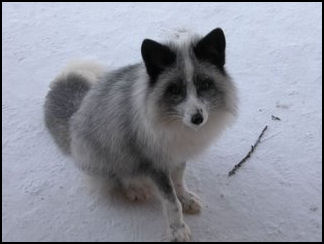
Hokkaido fox
Foxes in Japan are omnivorous. They eat nuts, fruits, insects, honey, leaves, acorns, other items from the forest and meat. Japanese Foxes are regarded as a subspecies.Kevin Short wrote in the Daily Yomiuri: The Japanese red fox, usually just called kitsune, feeds on all sorts of small to medium-size animal prey, including insects, crabs, frogs, birds and mice and other rodents. One of their favorite prey is the Japanese hare. Both these animals are speed demons, but the fox is just a wee bit faster. Foxes also eat a variety of fruits and berries, and will raid crops, and scavenge animal carcasses and even human garbage. [Source: Kevin Short, Daily Yomiuri, May 10, 2012]
“Foxes breed in underground dens, which they dig themselves. Litters usually consist of three to five pups, which stay with their mother, learning the tricks of survival, until their first autumn. Most of the pups then set out on their own, but some females may remain behind to help their mother raise a new set of pups the following spring.
“Zoologists recognize several dozen subspecies of red fox, two of which are found here in Japan. The Ezo red fox, or kita-kitsune (V.v. schrencki) lives on Hokkaido, and the Japanese red fox, or hondo-gitsune (V.v. japonica) on Honshu, Kyushu and Shikoku. The red fox (Vulpes vulpes) are one of the world's most widespread and successful carnivores. Their range includes almost all of the Eurasian and North American continents, and they live in habitats that vary from arctic tundra to full desert. The secret of their success is adaptability. They are intelligent, curious, and quick to take advantage of new feeding opportunities, especially in agricultural and even suburban landscapes.
Foxes, Religion and Folklore
In Japanese folklore foxes are regarded as clever and magical animal who act messengers for the gods, particularly the God of the Harvest, and are symbols of fertility. Killing one sometimes results in punishment by the gods. Small shrines for rice and harvest gods are found at Shinto shrines and some Buddhist temples. They are invariably guarded by foxes. Foxes are believed to have the power to change their forms, possess humans and cause people to have hallucinations so they can trick them. Their favorite entry point is under the fingernails. Their favorite food is said to be deep-fried tofu, which is often found in shrines next to fox statues. Foxes and tanukis are said to have the ability to cause hallucinations in people and trick them.
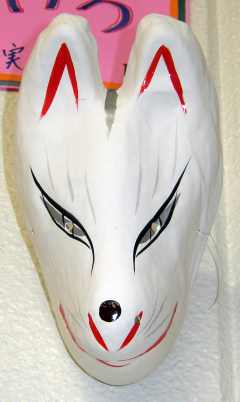
a fox Kevin Short wrote in the Daily Yomiuri, “Foxes are among the great perennial stars of Japanese folklore. To begin with, they are considered to be familiar spirits serving the immensely popular rice deity Inari. A set of two stone foxes stand watch in front of every Inari shrine. Some folklorists believe that foxes became associated with rice farming because of their role in controlling mice, hares and other agricultural pests. In the past farmers would even leave out food to attract foxes to their rice paddies. Foxes are thought to be especially fond of abura-age, thin slices of deep-fried tofu soy bean paste. Pockets of abura-age stuffed with rice are known as Inari-zushi. [Source: Kevin Short, Daily Yomiuri, May 10, 2012]
“Yo-gitsune is the Japanese word for fairy foxes. “In contrast to the favorable agricultural image, foxes have also been traditionally imagined as clever tricksters and shape-shifters. These yo-gitsune can be encountered in a wide variety of shapes and sizes. Like cats and many other Japanese fairy animals, their magical powers grow stronger with age. After living for a century or two, yo-gitsune become able to possess people, causing illness or insanity, and also to temporarily shape-shift into incredibly glamorous women. Stories abound of men falling hopelessly in love with and marrying these "foxy ladies.”
“In one famous story, a 10th-century nobleman saves a fox from a mob bent on killing it for its liver. A few days later, a beautiful woman mysteriously appears at his door. They fall madly in love, get married and have a son. Three years later, the woman suddenly disappears, leaving a note explaining to her husband that she was really just the fox whose life he had saved. Their son grows up to be Abe no Seimei, the famous Onmyoji Yin-Yang wizard who protects the imperial court and the capital city from all sorts of wicked spells and disasters.
“After living for a full millennium, fairy foxes may attain a formidable style with nine tails. Nine-tail foxes, or Kyubi no Kitsune, are of Chinese origin, but have also been active in Japan as well. During the Edo period (1603-1867), motifs depicting heroes ridding the land of these often ill-tempered nine-tail foxes were widely adopted into traditional theater, literature and art.
“Until quite recently, mental illnesses and emotional instability were frequently attributed to possession by fox spirits, especially in isolated rural villages. Even more frightening, there are families, called tsukimono-mochi, which are rumored to keep tiny fox spirits in vases or bamboo tubes. These spirits can be sent out on various missions, such as searching for gold or treasure, stealing, spying on people, or just causing all sorts of trouble and misfortune. The secrets of caring for and controlling these fox spirits, or in some cases similar dog or weasel spirits, are passed down from generation to generation among women of the household. Families which are rumored to possess fox spirits are feared and shunned.
“Another peculiarity of fairy foxes is that they tend to emit strange lights at night. One very famous spot for kitsune-bi fox-fire is the Inari shrine at Oji in Kita Ward, Tokyo. Every New Year's Eve foxes from all over the Kanto region are believed to assemble here under an ancient hackberry tree. The local farmers predict the yields of the coming season's crops by the number of glowing lights they count.
Ryukyu Flying Foxes
Ryukyu flying foxes (Pteropus dasymallus) range from the Ryukyu islands of Japan, which run from southern Japan to Taiwan, through parts of Taiwan. Japanese Ryukyu islands on which they are found include (Kuchinoerabu, Takara, Okinawa, Ishigaki, Iriomote, Hatoma, Obama, Yonakuni and some smaller islands. In Taiwan the reside in Kashoto Island, east coast Taiwan, and the Daito Islands. Ryukyu flying foxes are in the suborder Megachiroptera of bats, which is comprised of large fruit bats and flying foxes, which are the world’s largest bats. Their average weight is 0.44 kilogram (a little less than a pound). Ryukyu flying foxes are slightly smaller than Indian flying foxes, which are among the world’s largest bats. Ryukyu flying foxes have a a wingspan of 1.24 to 1.41 meters (4 foot 1 inch – 4 foot 8 inches. Their forearm length is approximately 14 centimeters (5.5 inches. Their body is covered in long hairs, making the body seem almost woolly. Their ears are small and pointed, and are difficult to see beneath its thick fur. Its flight membranes are dark brown in color. Their average lifespan in captivity is up 24 years. Sexual Dimorphism (differences between males and females) is not present: Both sexes are roughly equal in size and look similar. [Source: Brian Putz, Animal Diversity Web (ADW) /=]
There are five subspecies of Ryukyu flying foxes: 1) the Daito fruit bat (P. d. daitoensis); 2 Erabu fruit bat (, P. d. dasymallus); 3)Taiwanese fruit bat (P. d. formosus); 4) Orii's fruit bat (, P. d. inopinatus); and 5) Yaeyama fruit bat (P. d. yayeyamae). Some of the subspecies have distinguishing characteristics. . Daito fruit bats have brown wings and a yellow belly and back. The sides of the back are brown. The body is 22.1 centimeters long and the forearm length 134 millimeters. Erabu fruit bats are the largest and darkest of the subspecies. The fur on their head is blackish head; their body is usually dark brown to black, with a a cream colored area around the neck. Their forearm length is around 13.7 centimeters. Taiwanese fruit bats are believed to be extinct in the wild. Orii’s fruit bats a brown muzzle and a patch of darker fur that interrupts the white collar around its neck and an exposed lacrimal foramen. Yaeyama fruit bats are the smallest subspecies. Their fur color varies. Their head is usually brown and their neck, cinnamon colored. /=\
Ryukyu flying foxes primarily frugivores (eat fruits) but are also considered herbivores (primarily eat plants or plants parts), folivores (eat leaves) and omnivores (eat a variety of things, including plants and animals). Animal foods include insects. Fruit makes up the largest part of their diet. They seem to have a preference for figs but also eat flowers in the spring and leaves year round. One study of Erabu fruit bats found they had more diverse diet than any other pteropodid bats ever studied. Their diet includes bark, 17 species of fruit, nine species of leaves, five species of flowers, and eight species of insects on Kuchinoerabu Island. /=\
On the IUCN Red List Ryukyu flying foxes are listed as Near Threatened. In CITES (Convention on International Trade in Endangered Species of Wild) they are in Appendix II, which lists species not necessarily threatened with extinction now but that may become so unless trade is closely controlled. Deforestation, hunting, and typhoons are threats. Clearing away forests for agriculture takes away roosting and food supplies. The Taiwanese fruit bat’s extinction in the wild is believed to have been caused by hunting and deforestation. Typhoons can have a big impact on forest structure by knocking down trees.
RELATED ARTICLES:
FLYING FOXES: CHARACTERISTICS, BEHAVIOR AND REPRODUCTION factsanddetails.com
WORLD’S BIGGEST BATS — LARGE, INDIAN AND GREAT FLYING FOXES — AND THEIR CHARACTERISTICS AND BEHAVIOR factsanddetails.com
FLYING FOXES OF THE ISLANDS OF INDONESIA AND THE PHILIPPINES factsanddetails.com
BATS, CHARACTERISTICS, FLIGHT, REPRODUCTION factsanddetails.com
Ryukyu Flying Fox Behavior
Ryukyu flying foxes are arboreal (live mainly in trees where they roost), nocturnal (active at night), motile (move around as opposed to being stationary) and colonial (live together in groups or in close proximity to each other). Daito fruit bats may roost singly, in small groups, or even large camps. They change roosting sites from time to time. Fruit bats and flying foxes often form large groups on branches. The other Ryukyu flying foxes subspecies live in colonies and usually stay at the same roosting sites.
Ryukyu flying foxes sense and communicate using vision, touch, sound and chemicals usually detected with smell. They don’t echolocate like smaller bats who mainly use echolocation to entrap flying insects. Flying foxes have relatively large eyes and teeth adapted for eating fruit. They use their eyes and sense of smell to locate fruit and other foods. They also employ pheromones (chemicals released into air or water that are detected by and responded to by other animals of the same species).
Ryukyu flying foxes engage in seasonal breeding. Mating takes place between November and early January. The number of offspring is one. The gestation period ranges from four to six months. The reproductive rates of these bats is relatively low in part because they only give birth to one offspring. . In most fruit bats females don't give birth for the first time until they are one or two years old. Mating for Daito fruit bats takes place between November and early January and birth occurs between May and June.
Image Sources: Japan Animals blogs except tanuki statues (Ray Kinnane), Wikimedia Commons
Text Sources: Animal Diversity Web animaldiversity.org ; National Geographic, Live Science, Natural History magazine, David Attenborough books, Daily Yomiuri, Yomiuri Shimbun, Japan National Tourist Organization (JNTO), New York Times, Washington Post, Los Angeles Times, Smithsonian magazine, Discover magazine, The New Yorker, Time, BBC, CNN, Reuters, Associated Press, AFP, Lonely Planet Guides, Wikipedia, The Guardian, Top Secret Animal Attack Files website and various books and other publications.
Last updated March 2025


